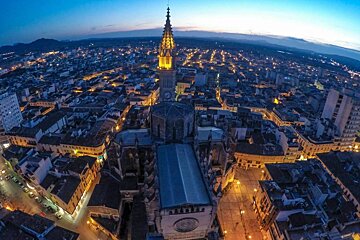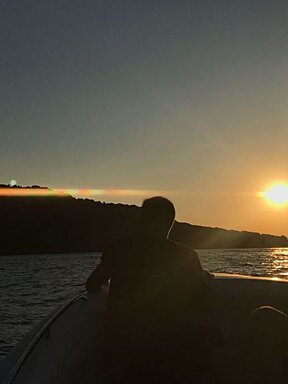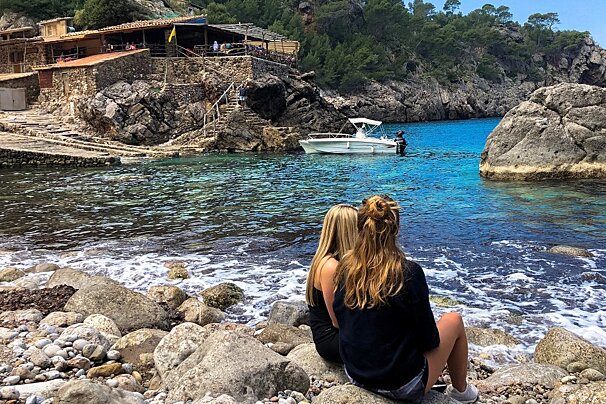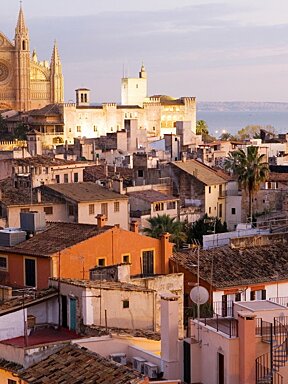
© AJ Manacor

© Aj Manacor

© AJ Manacor

© AJ Manacor

© AJ Manacor
Manacor, Mallorca
Industrial centre and Mallorca's second city
Mallorca’s second city, Manacor, sits around 10km from the eastern coastline. It used to be an agricultural town but, with the help of the railway line that was opened in 1879, it became the industrial and commercial centre of the area.
Today, the train line between Palma and Manacor runs every hour and so it has become a popular mode of transport for islanders to commute to the capital for work. Very much a working industrial city, Manacor is full of local residents. It's within easy reach of some of the island’s most beautiful beaches, while the surrounding countryside also has its appeal.
Currently, tourists mainly come to Manacor to visit Majorica's factory shop, home to the island’s famous artificial pearl industry. The city has also been put on the map as the birthplace of tennis superstar Rafael Nadal, who still lives here with his family when he's not playing on the tennis circuit. Nadal has even opened up a state-of-the-art tennis academy, sports centre and museum in his hometown.
In recent years, the city’s residents have been working hard to make this city a more attractive place for visitors. It's probably best to visit Manacor on a Monday morning to enjoy its weekly market. In true Spanish style, there are also plenty of fun fiestas and fairs to enjoy here throughout the year.
History & Culture in Manacor
The name ‘Manacor’ comes from the Catalan 'Man a Cor’ which means ‘hand on heart’. Manacor was first granted a municipality in the year 1200. However, artificial caves and burial sites in this region have been traced back to as far as 2000 BC, some remains of Talaiotic villages like S’Hospitalet Vell, Boc i Bellver, Bendrix, Son Sureda and Sa Gruta, are examples of the area’s ancient history.
A turning point in Manacor’s modern history was when the railway between Manacor and Inca opened in 1879 and led to the town’s thriving manufacturing industries. Not only artificial pearls but pottery, wine, liqueurs, furniture and textiles became important for economic and population growth, which led to Manacor being officially upgraded to town status in 1912.
Sights & Attractions in Manacor
Architectural sights
Despite the lack of obvious sights within the city itself, the narrow streets behind the church make for a pleasant place to stroll and soak up the atmosphere of everyday Mallorca. The local church, the Esglesia dels Delors de Nostra Senyora, was built on the site of a mosque at the end of the 19th century and its minaret-style tower can be seen for miles. Look inside to see the figure of Christ with scrawny hair and a skirt – pilgrims queue up to kiss his bloodstained feet. On this same square, you will find the Palace Tower or Torre del Palau which is all that is left of the old Royal Palace, once a residence of King Jaume II.
The Torre de ses Puntes is a tower from the 13th to the 15th centuries which has been restored and become a cultural centre for art and photography exhibitions. To see some lovely architecture, take a stroll around the area of Sa Bassa, which has historic mansions from the 17th to the 19th centuries and is also home to the Saturday morning market. The Convent of Sant Vincenç Ferrer is worth a look, as it boasts a beautiful arcaded cloister and rectory.
Museums
The Manacor History Museum, located on the road to Cales de Mallorca, is housed in Torre dels Enagistes, a Gothic mansion house dating from the 13th century. Exhibits include collections of archaeological sites and historical evidence of life around Manacor through the Middle Ages up until the 20th century.
Cuevas del Drach
If you are willing to travel a few kilometres down to the east coast, there are a number of impressive cave systems to explore in Porto Cristo. The Caves (or Cuevas) del Drach are one of Mallorca’s biggest tourist attractions, in fact, they are some of the most impressive in the whole of Europe especially as they feature an underground lake. The tour takes about an hour and includes a classical music concert and boat trip on the lake.
Beaches in Manacor
For beaches, you will need to head to the east coast a few kilometres away. Cala Millor is a large-scale resort which has a long stretch of beach and all the facilities and watersports you could wish for. Cala Romantica, S’Illot, Porto Cristo and Cala Murada are small pretty beaches nearby. For something more remote, try Cala Varques.
Events in Manacor
Markets
If you want to visit an authentic Mallorcan market, then Manacor provides plenty of opportunities as there is a fruit and vegetables market every morning except Sundays in Plaça Constitució from 08:00 to 13:00. Manacor’s weekly market is one of the busiest on the island and is held on Mondays in Placa Ramon Llull, also from 08:00 to 13:00.
Annual fiestas
Manacor joins many other towns and villages in celebrating Sant Antoni on January 17th, but this city puts on a particularly spectacular display. Expect devil dancing, bonfires and more. The summertime brings the traditional fiesta in celebration of Sant Jaume at the end of July. The city comes to life with music, fireworks, market stalls and entertainment for over a week.
On the 24th June, the town’s residents have a unique ritual dating back over a century, where they gather at a willow tree located in the grounds of a nearby country house. This tree is believed to have special healing powers for children so they are passed through the branches each year.
Seasonal fairs
In true Spanish style, there are plenty of seasonal fairs to enjoy all throughout the year where you will find stalls selling local produce, traditional dances, music and entertainment for both adults and children. Manacor’s Spring Fair is usually held at the end of May and the beginning of June, marking the start of the summer on the island. Keep your eyes peeled for the evening wine fair which is usually held during this event and takes place in the cloister of Sant Vicenç Ferrer. The Spring Fair’s grand finale is particularly popular for families with small children as there’s an impressive parade of floats.
The local Autumn Fair is held in September. Crafts and gastronomy play an important role in this event, along with concerts and exhibitions. There is also a fairground to keep the children entertained. Last, but not least, Manacor’s Christmas Craft Fair or ‘Fira de Nadal’, usually held for over two weeks in December is a great way to get into the festive spirit.
Things to do in Manacor
Pearl factory visit
Majorica is the best-known artificial pearl factory in the world and produces 50 million pearls a year. They use the scales of millions of fish and are said to be indistinguishable from the real thing, and almost as expensive. In Manacor, you can visit the factory shop and a small exhibition explaining the production process.
Rafa Nadal Sport-Xperience Museum
An interactive museum for the whole family to enjoy. From Rafa Nadal’s trophies and a tennis museum to high-tech simulators which include Formula 1, tennis and mountain biking experiences.
Horse racing
Hipodrom Son Pardo is a horse racing track in Manacor. It specializes in horse and cart races and has a great atmosphere.
Safari park
There is a safari zoo close by which you can tour either with your own car or by the safari train. Catch a glimpse of exotic animals like giraffes, rhinoceroses, zebras, gazelles, gnus and monkeys.
Wine tastings & tours
There is a thriving wine industry around Manacor, and a trip to a vineyard for tastings or tours can be arranged if you call in advance. Es Fangar is one of the biggest estates on the island and offers a premium experience when it comes to their wine tour and tastings. Within Manacor, Vins Miquel Gelabert is a great place to sample a selection of Mallorcan wines.
Shopping
As Mallorca's second city, there are plenty of shops in Manacor. In recent years, lots of small boutiques have settled in the middle of town. However, the city is particularly popular for its ornate furniture shops which might be more attractive to expats with holiday homes on the island rather than the average tourist. Be warned, siestas are taken seriously here so many of the shops shut their doors for an extra-long lunch break.
Cycling
There are several cycle routes in the area, and the Tourist Office has a number of route maps you can follow whilst exploring some of Mallorca’s unspoiled countryside.
Dining in Manacor
Some restaurants in Manacor have been firmly placed on the map for a number of decades. Can March originally opened in 1925 and, having passed down through several generations, it has kept up with the times. Today, the original owners’ grandsons work with the chef to create a ‘new Mallorcan’ cuisine. Tasting menus are the way to go here, so make sure you arrive hungry. Another age-old favourite is Moli den Sopa which opened its doors in 1965. It’s a smart restaurant offering a variety of food including local specialities, international trends, seafood and a tasting menu.
Sa Cuina is a favourite amongst the locals and is particularly popular for its reasonably priced ‘menu del dia’. If you are craving Italian food, then Tutto Pasta is a top choice. Vegetarians and vegans should make their way to Plaer Vegetaria. Rafa Nadal Sport Café & Restaurant is a good shout if you are that side of town and want something healthy. When nothing but a nice little patisserie will do, then Ca’n Roca has a good selection of bread, cakes and other sweet treats.
Hotels in Manacor
There are a number of rural hotels just outside Manacor, ideal for peace and relaxation away from the hustle and bustle of some of the more touristy locations on the island. Otherwise, a few countryside villas are available for large groups and families looking for a more private experience.
A highly regarded hotel is La Reserva Rotana. Housed in a 17th-century mansion, it overlooks a valley and some of Mallorca’s most beautiful countryside. The building has been tastefully decorated with antique furnishings and there's a gourmet restaurant, BBQ bar and lovely swimming pool. However, its defining feature is the private 9-hole golf course reserved exclusively for guests.
Son Amoixa Vell is a traditionally styled finca which boasts large rooms, exposed beams and a rustic vibe. Whilst in many ways you feel like you have been transported back in time, it does feature an outdoor pool, furnished terrace and a sauna.
How to get to Manacor
By car
Manacor is an easy 45-minute drive from Palma Airport by car. Head towards Manacor along the Ma-15, which will take you all the way to Mallorca's second city.
Public transport
The TIB A42 is a direct bus travelling between the airport and Manacor a few times per day and takes 45 minutes. You can also catch bus number 1 to the bus station at Plaça d'Espanya in Palma and then catch the T3 train from the train station here which leaves every hour and takes just over an hour to Manacor.






























